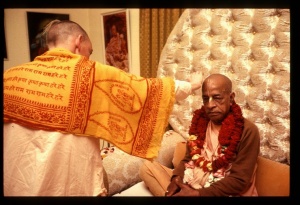CC Adi 10.112 (1975)

A.C. Bhaktivedanta Swami Prabhupada
TEXT 112
- puruṣottama, śrī-gālīma, jagannātha-dāsa
- śrī-candraśekhara vaidya, dvija haridāsa
SYNONYMS
puruṣottama—of the name Puruṣottama; śrī-gālīma—of the name Śrī Gālīma; jagannātha-dāsa—of the name Jagannātha dāsa; śrī-candreśekhara vaidya—of the name Śrī Candraśekhara Vaidya; dvija haridāsa—of the name Dvija Haridāsa.
TRANSLATION
The sixty-eighth branch of the original tree was Puruṣottama, the sixty-ninth was Śrī Gālīma, the seventieth was Jagannātha dāsa, the seventy-first was Śrī Candraśekhara Vaidya, and the seventy-second was Dvija Haridāsa.
PURPORT
There is some question about whether Dvija Haridāsa was the author of Aṣṭottara-śata-nāma. He had two sons named Śrīdāma and Gokulānanda, who were disciples of Śrī Advaita Ācārya. Their village, Kāñcana-gaḍiyā, is situated within five miles of the Bājārasāu station, the fifth station from Ājīmagañja in the district of Murśidābād, West Bengal.